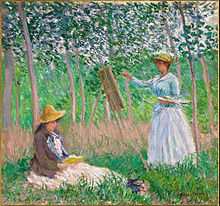Blanche Hoschedé-Monet
Blanche Hoschedé-Monet (born November 12, 1865 in Paris ; died December 10, 1947 in Nice ) was a French painter. She lived first as a stepchild and then as a daughter-in-law for several decades in the house of the painter Claude Monet , whose work influenced her own pictures.
Life
Blanche Hoschedé was born in Paris in 1865 as the second daughter of the entrepreneur Ernest Hoschedé and his wife Alice , née Raingo. Her father amassed an important art collection and knew several contemporary painters personally. In 1876 the painter Claude Monet visited the family at their Rottembourg castle in Montgeron . Monet's works in the Hoschedé collection also included the famous painting Impression, Sunrise . In 1877 Ernest Hoschedé got into financial difficulties and had to flee briefly to Belgium from his creditors. The parents' art collection was auctioned off in 1878. The mother Alice Hoschedé moved with her six children to Claude Monet in Vétheuil . After Monet's sick wife Camille died in 1879, Alice Hoschedé and Claude Monet lived as an unmarried couple with the children of both marriages. It was only after Ernest Hoschedé's death in 1891 that Claude Monet and Alice Hoschedé married in 1892. Claude Monet was now officially the stepfather of Blanche Hoschedé.
Blanche Hoschedé admired Monet's work early on and began painting himself in the early 1880s. In the summer of 1882 she was on vacation with Monet in Pourville on the Normandy coast . From 1883 the Hoschedé-Monet family lived in Giverny . Blanche Hoschedé was Monet's model on several occasions from 1883. She assisted Monet with painting and was inspired by him to create her own pictures, but without being pushed into an artistic direction. However, she was not his official student and did not receive any other artistic training, but largely developed her painting as an autodidact. Above all, he created landscape paintings in Giverny and in the Seine Valley, which show a brushwork in the style of Impressionism .
In Giverny, Blanche Hoschedé had contact with the American artist colony. She had a brief love affair with the painter John Leslie Breck , but Claude Monet did not tolerate it. Breck went back to the United States in 1890. The painter Theodore Earl Butler married her sister Suzanne Hoschedé in 1892 , after whose death in 1899 he married her sister Marthe. She herself married Jean Monet, the eldest son of Claude Monet, in 1897 and has been known as Blanche Hoschedé-Monet ever since. Jean Monet worked as a chemist in his uncle Léon Monet's company and the couple first lived in Rouen , where they moved into an apartment at 239 rue de Renard, and later in Beaumont-le-Roger . In the years of marriage she continued her painting, but remained stylistically connected to the model of Claude Monet. From 1905 she exhibited regularly in the Paris Salon des indépendants and from 1907 she showed her works in Rouen in the regional Salon des artistes rouennais .
After the death of her mother Alice Hoschedé-Monet in 1911 and her husband Jean Monet in 1914, Blanche Hoschedé-Monet moved to Giverny to live with her father-in-law. She gave up painting for the time being and took care of Claude Monet. The statesman Georges Clemenceau , a friend of Claude Monet, gave her the nickname l'ange bleu (German The Blue Angel ) because she looked after the painter in the last phase of his life.
After Claude Monet's death in 1926, she resumed painting, developing a more naturalistic style of painting. Between 1927 and 1929 she repeatedly visited Clemenceau in Saint-Vincent-sur-Jard and created several pictures there. Other trips took her to Brittany , the Normandy coast , Auvergne , Provence , the Côte d'Azur and Italy. In addition to landscape paintings, she also created still lifes and interiors .
Blanche Hoschedé-Monet lived in Claude Monet's house in Giverny until she died . There she received guests such as Pierre Bonnard , Paul Signac and Édouard Vuillard and took care of the maintenance of the gardens with the famous water lily pond. She died in the winter of 1947 while taking a spa stay in Nice. Her grave is in the Giverny village cemetery. Monet's house then passed into the ownership of her brother-in-law Michel Monet , who bequeathed it to the Institut de France in 1966 .
Works by Blanche Hoschedé-Monet can be found in the Musée d'Orsay and the Musée Marmottan Monet in Paris, the Musée Municipal AG Poulain in Vernon, the Musée des Augustins in Toulouse, the Musée Toulouse-Lautrec in Albi and the Musée des beaux-arts de Rouen . In 2010 the Musée de Louviers dedicated a solo exhibition to her.
literature
- Renate Treydel: Hoschedé-Monet, Blanche . In: General Artist Lexicon . The visual artists of all times and peoples (AKL). Volume 75, de Gruyter, Berlin 2012, ISBN 978-3-11-023180-9 , p. 47 f.
- Sophie Fourny-Dargère: Blanche Hoschedé-Monet 1865-1947; une artiste de Giverny , exhibition catalog Musée Municipal AG Poulain, Vernon 1991.
- Jean-Pierre Hoschedé: Blanche Hoschedé-Monet, peintre impressionniste . Lecerf, Rouen 1961.
- Philippe Piguet: Blanche Hoschedé-Monet, un destin impressionniste . Édition Point de Vues, Bonsecours 2010, ISBN 978-2-915548-48-8 .
- Judith Cernogora: Portraits de femmes . Point de vues, Rouen 2016, ISBN 978-2-37195-009-2 .
Web links
Individual evidence
- ^ A b Philippe Piguet: A city for Impressionism - Monet, Pissarro, and Gauguin in Rouen (catalog) . Ed .: Laurent Salomé. Skira Flammarion / Musée des Beaux-Arts de Rouen, Paris / Rouen 2010, ISBN 978-2-08-124399-6 , p. 348 .
| personal data | |
|---|---|
| SURNAME | Hoschedé-Monet, Blanche |
| BRIEF DESCRIPTION | French painter |
| DATE OF BIRTH | November 12, 1865 |
| PLACE OF BIRTH | Paris |
| DATE OF DEATH | December 10, 1947 |
| Place of death | Nice |





